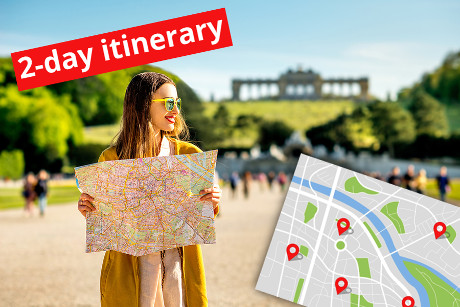Welcome to your travel guide and tourist information about short trips and city breaks in Vienna, Austria: www.viennahipsterguide.com
The Most Famous Buildings and Architecture to See in Vienna, Austria
Vienna is a must-see destination for architecture students and the lovers of the dominating art movements of the late 19th century and the first half of the 20th century. Jugendstil (Art Nouveau, Secession) and Viennese Modernism is richly represented in the city's cultural heritage. But if you seek more recent buildings, the Austrian capital has a range of sights for you, too. Browse our list below and put your own route plan together for an architecture themed journey.
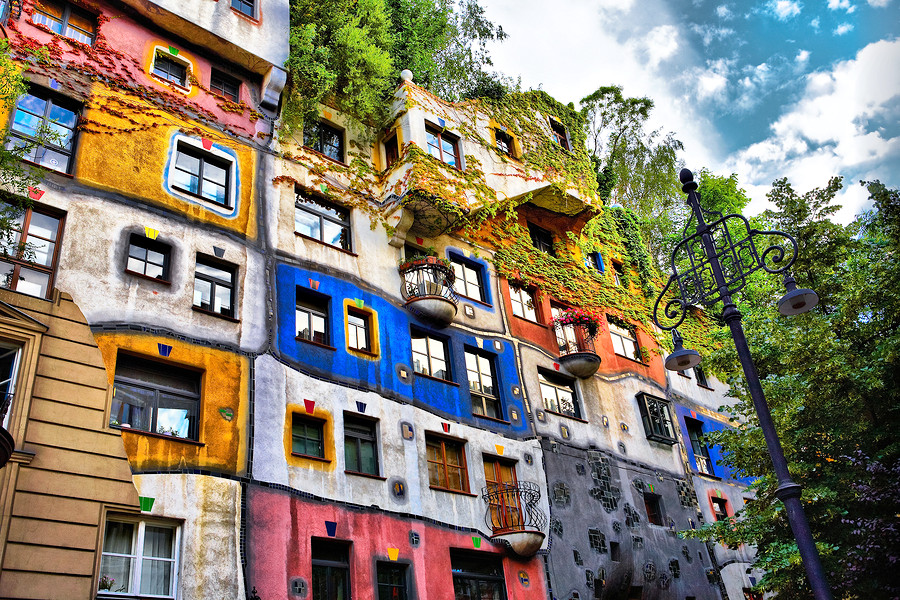
Hundertwasser Haus
1. Art Nouveau / Jugendstil / Secession style buildings / Viennese Modernism in Vienna:
Here is a list of the most notable Jugendstil buildings located in Vienna.
1.) Underground station Karlsplatz (U-bahn) - by Otto Wagner
Address: Karlsplatz, 1040 Wien
Web: Otto Wagner Pavillon
Located at Karlsplatz, this underground station is one of Otto Wagner’s masterpieces, designed with his signature Art Nouveau style. The elegant, airy design incorporates wrought-iron elements, marble, and ceramic tiles, creating a stunning juxtaposition of function and beauty. As part of the Vienna U-Bahn system, it's not just a transit hub but a piece of architectural history. Tourists can admire Wagner's vision for modern architecture while experiencing the convenience of Vienna's public transport. The station is a prime example of early 20th-century design, blending art with everyday life.


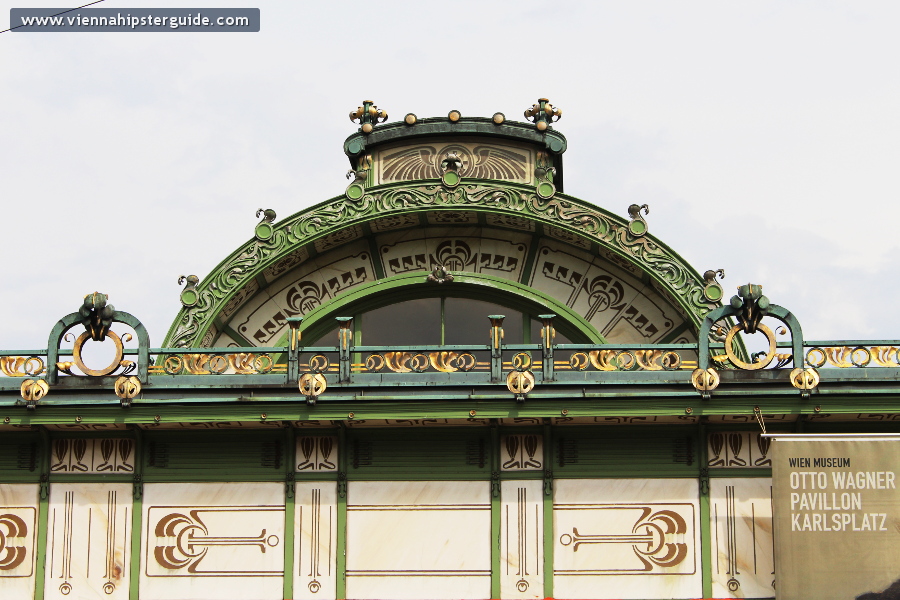
2.) Underground station Schönbrunn (U-bahn) - by Otto Wagner
Address: Schönbrunn, 1130 Wien
Another gem by Otto Wagner, the Schönbrunn U-Bahn station features his trademark blend of modernism and organic Art Nouveau elements. Located near the famous Schönbrunn Palace, this station has been designed to complement the grandeur of the area, with clean lines, geometric motifs, and luxurious materials. The station provides visitors with both a functional means of transport and a chance to appreciate Wagner's forward-thinking approach to integrating aesthetic appeal into public infrastructure. A visit offers a unique glimpse into Vienna’s commitment to making everyday spaces both beautiful and useful.

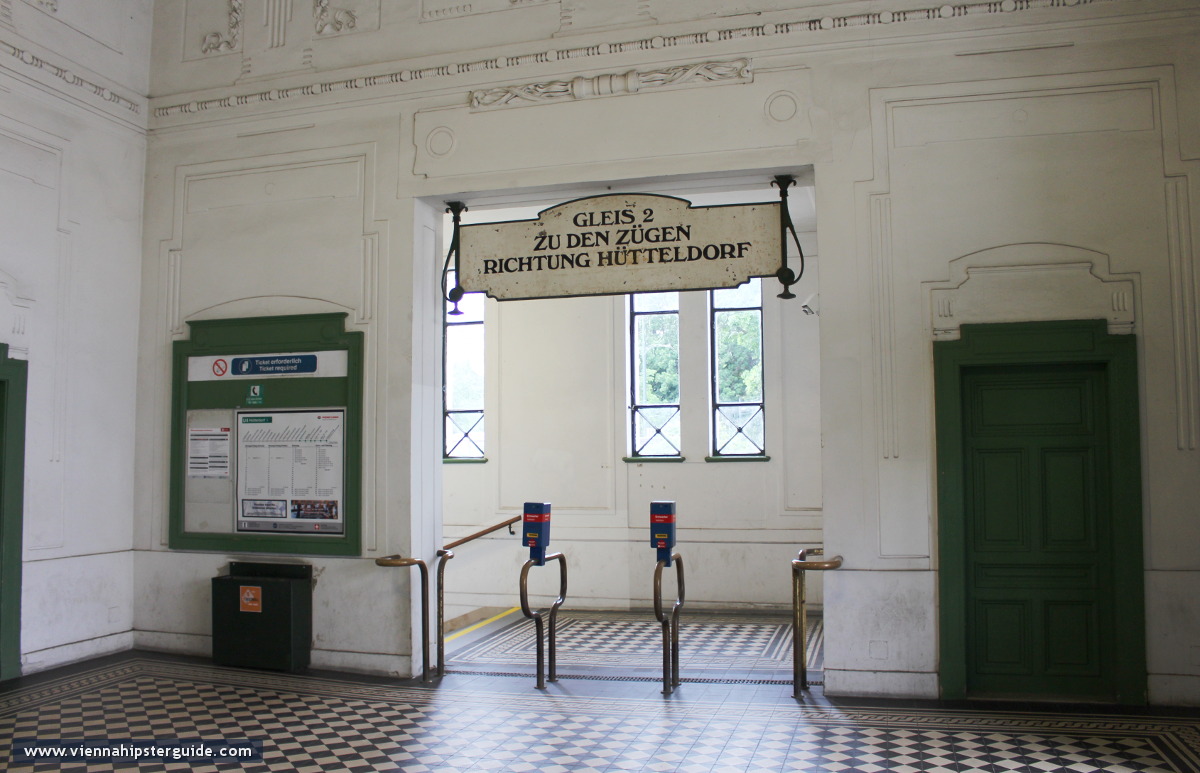
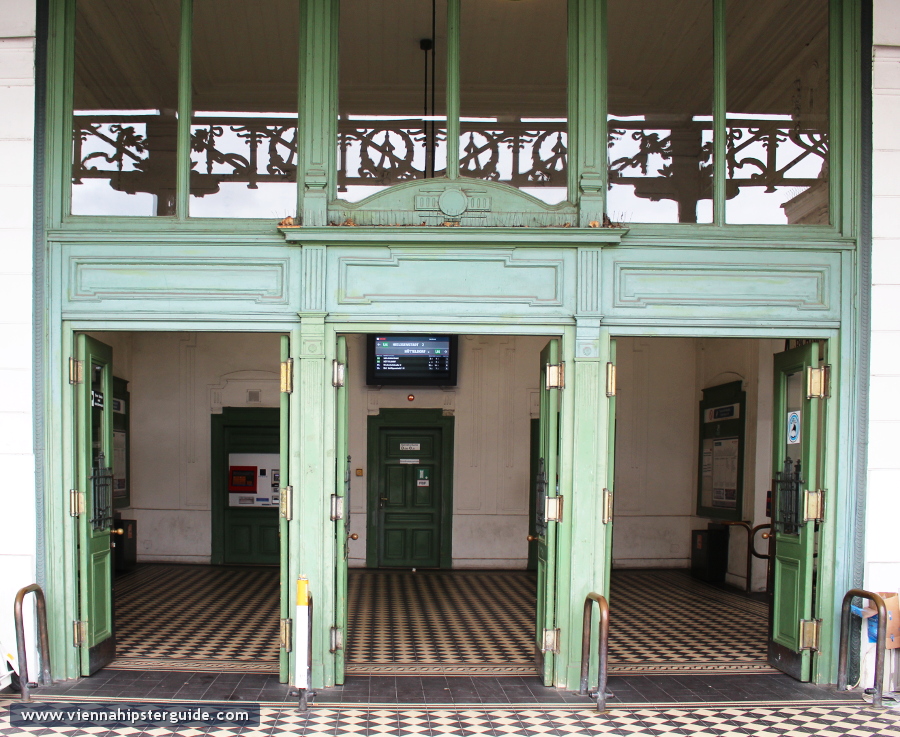
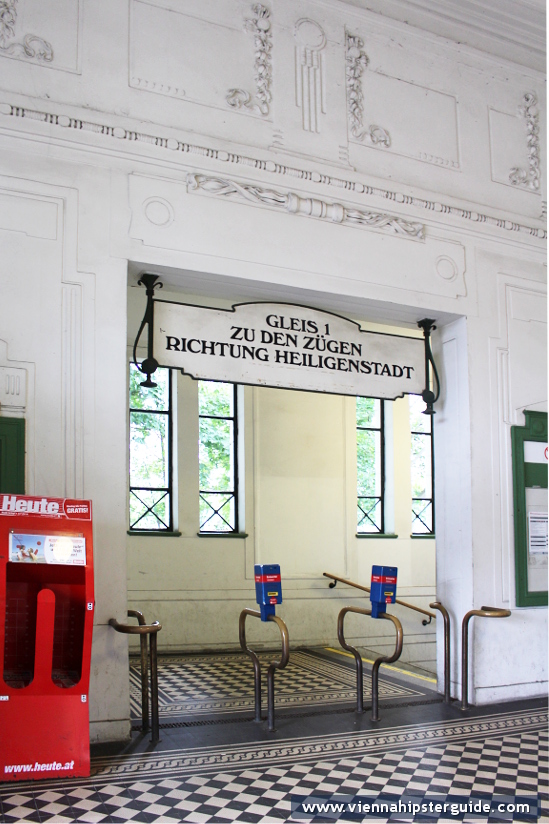

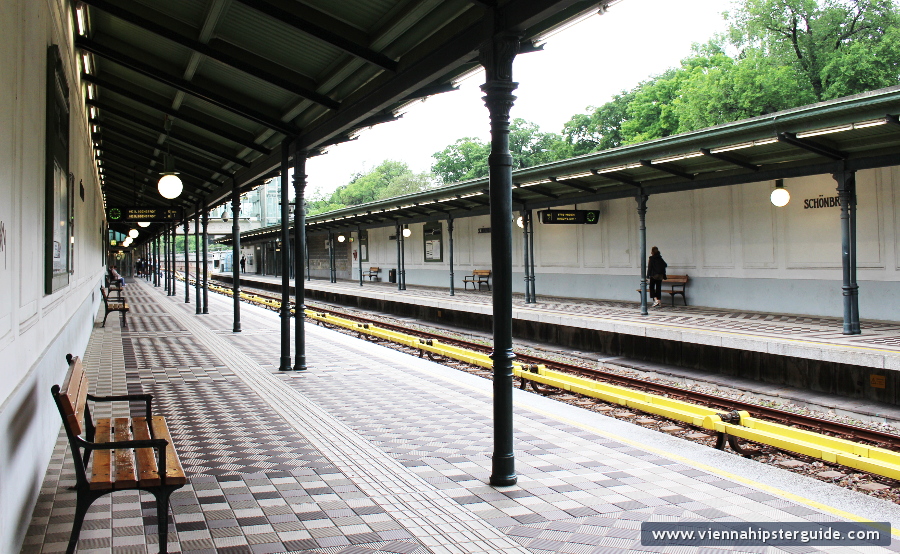
3.) Palmenhaus Schönbrunn / Palm House in Schönbrunn park
Address: Schlosspark, 1130 Wien
Web: Palmenhaus Schönbrunn
The Palmenhaus Schönbrunn is an exquisite example of Art Nouveau architecture, blending the elegance of glass and iron. Situated within the Schönbrunn Palace Gardens, this historic greenhouse houses a variety of tropical plants, making it a serene escape for nature lovers and architecture enthusiasts alike. The glass structure is an architectural feat, with its sweeping curves and intricately detailed metalwork. Visitors can marvel at both the botanical wonders and the building’s beautiful design, which has stood as a symbol of Vienna's commitment to natural beauty and architectural innovation.


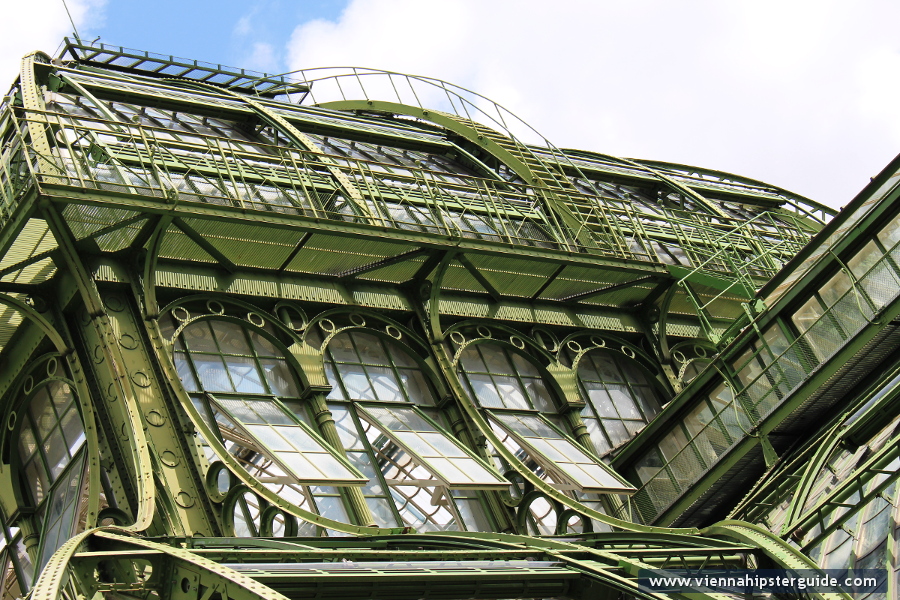

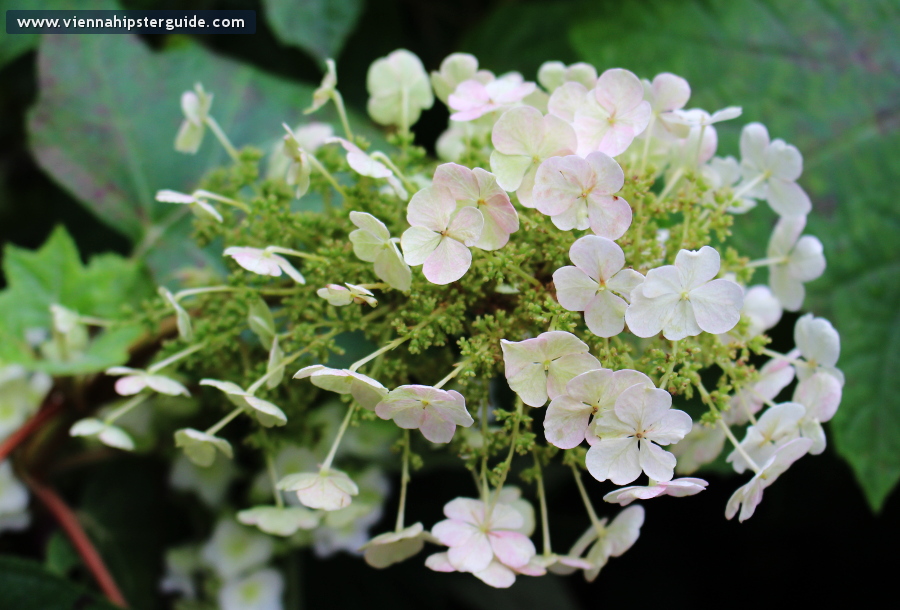
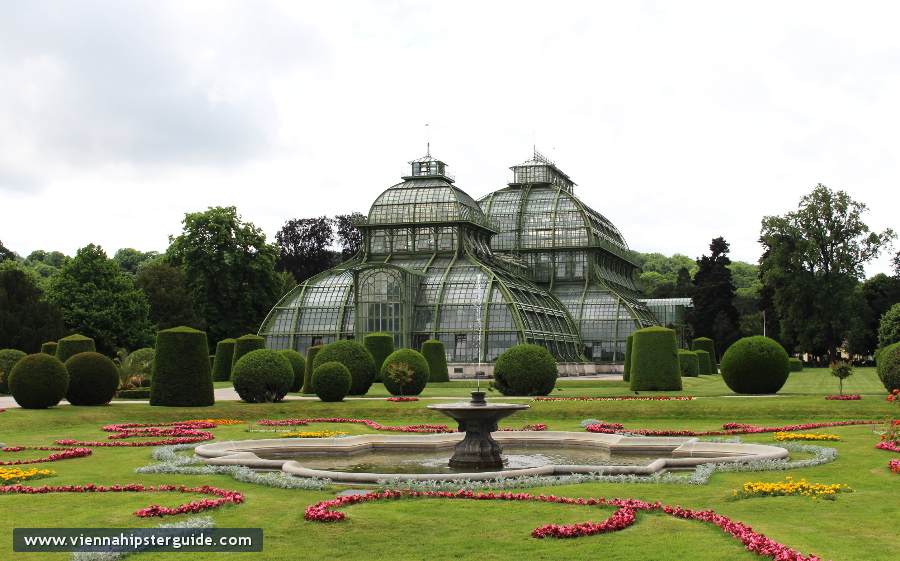
4.) Hofpavillon Schönbrunn - by Otto Wagner
Address: Schönbrunner Schloßstraße, 1130 Wien
The Hofpavillon Schönbrunn is an iconic pavilion designed by Otto Wagner, located on the grounds of the Schönbrunn Palace. This beautifully restored structure was originally built for Emperor Franz Joseph I’s use and exemplifies the harmonious blend of modernist and ornamental Art Nouveau style. With its elegant proportions, intricate detailing, and use of high-quality materials, it offers a glimpse into Vienna’s imperial past while showcasing the cutting-edge design of the early 20th century. Tourists visiting Schönbrunn should not miss the opportunity to explore this architectural gem amidst the lush palace gardens.
5.) Otto Wagner Schützenhaus
Address: Obere Donaustraße 26, 1020 Wien
Located on Obere Donaustraße, the Schützenhaus by Otto Wagner is a prime example of his distinctive Jugendstil architecture. Built as a shooting club house, it combines modern design elements with traditional forms, featuring intricate ceramic details and harmonious proportions. The building’s bold, geometric forms and decorative surfaces reflect Wagner’s innovative approach to architecture, where aesthetics and functionality go hand in hand. Today, visitors can explore this architectural jewel and appreciate Wagner's vision of modern, yet accessible, public spaces—perfect for architecture buffs and history enthusiasts alike.

6.) Majolika Haus - by Otto Wagner
Address: Linke Wienzeile 40, 1060 Wien
The Majolika Haus is one of Otto Wagner's most celebrated works, located on Linke Wienzeile. With its distinctive ceramic facade covered in colorful tiles, this building stands as a testament to the vibrant potential of Art Nouveau. The playful and decorative style of the facade is a departure from the typical monochrome facades of the time, making it a landmark in Vienna's architectural landscape. Visitors are drawn to the house not only for its architectural beauty but also for the opportunity to see how Wagner brought art into everyday living spaces, making it a must-see for art and architecture lovers.

7.) Kettenbrückengasse underground station, U4 - by Otto Wagner
Address: Kettenbrückengasse, 1050 Wien
The Kettenbrückengasse U-Bahn station is another remarkable design by Otto Wagner, found on the U4 line. Featuring his signature clean lines, geometric patterns, and decorative tiles, this station exemplifies Wagner’s approach to transforming functional spaces into works of art. The station’s design harmonizes with the surrounding area while offering a modern yet timeless aesthetic. Visitors can take a short trip to this station to experience how public spaces can be both utilitarian and visually inspiring. It's a great stop for those wanting to immerse themselves in Vienna's rich architectural heritage.
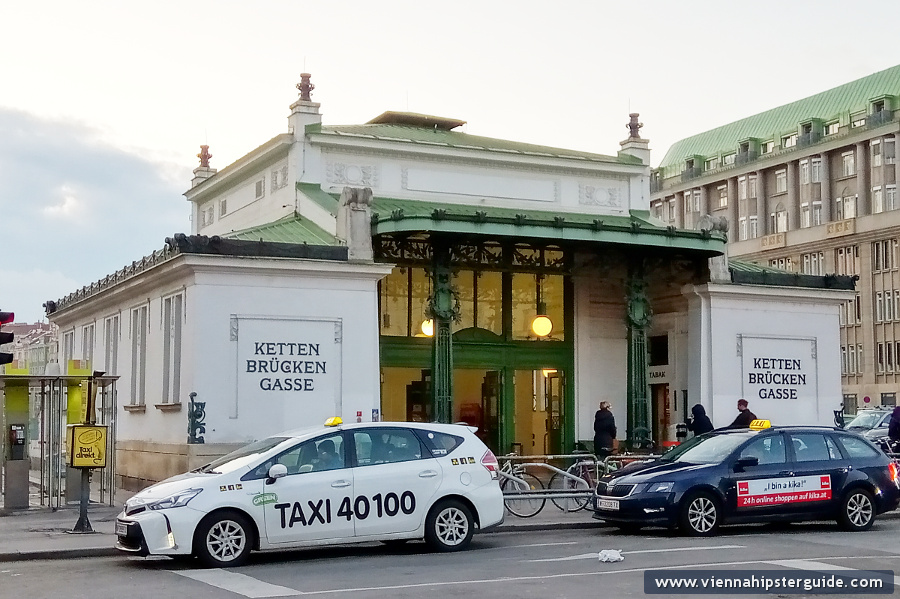
8.) Medallion Haus - by Otto Wagner
Address: Linke Wienzeile 38, 1060 Wien
The Medallion Haus, located on Linke Wienzeile, is an iconic structure designed by Otto Wagner. With its intricate medallion motifs and elegant facade, the building showcases Wagner's mastery of Art Nouveau aesthetics. The building's charming, ornamental exterior draws attention with its use of colorful tiles and decorative elements, blending functional design with artistic flair. Tourists visiting this building can enjoy its beauty while also exploring its historical significance as part of the larger architectural movement of the early 20th century. It offers a unique opportunity to experience Vienna’s transition into modern design.

9.) Secession building - by Joseph Olbrich
Address: Friedrichstraße 12, 1010 Wien
The Secession Building, designed by Joseph Olbrich, is an architectural landmark and the symbol of Vienna’s avant-garde movement. Completed in 1898, it is the home of the Vienna Secession, a group of artists who sought to break free from traditional academic art. The building’s distinctive dome, covered in gilded laurel leaves, stands out against the city’s skyline. Visitors can admire the harmonious fusion of classical and modern elements in the structure, while also exploring the exhibitions within. It’s a must-visit for those interested in Art Nouveau, as it perfectly encapsulates the spirit of the era.

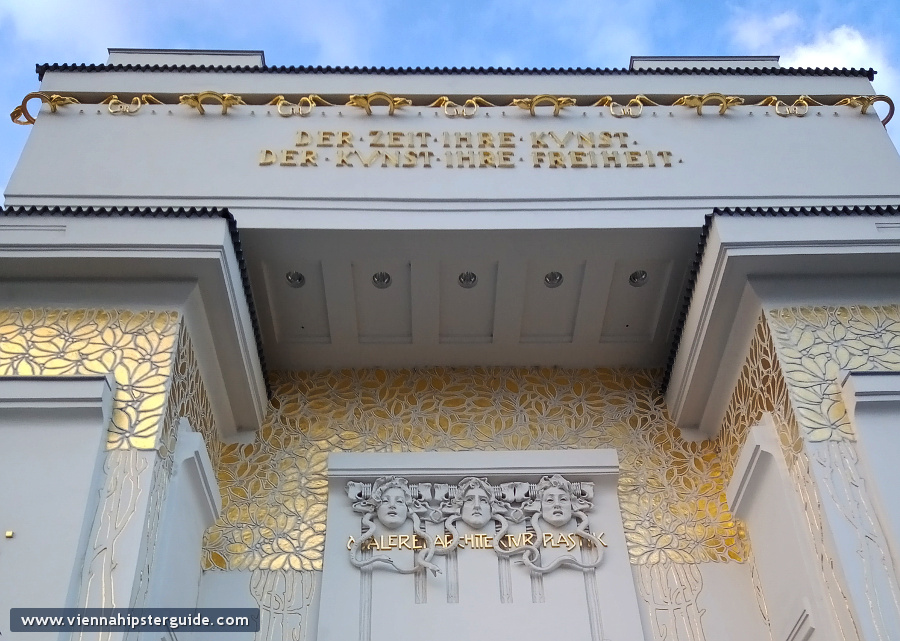
10.) Österreichische Postsparkasse / Austrian Postal Savings Bank - by Otto Wagner
Address: Georg-Coch-Platz 2, 1010 Wien
The Österreichische Postsparkasse, designed by Otto Wagner, is a masterpiece of early modern architecture, located on Georg-Coch-Platz. Its clean lines, functional layout, and use of metal and glass break away from traditional bank designs, demonstrating Wagner’s vision of a more industrial yet elegant approach to public buildings. The structure’s use of modern materials, such as reinforced concrete, was groundbreaking at the time. Tourists visiting this building can marvel at its forward-thinking design while gaining insight into Vienna’s modernization during the early 20th century. It’s a key stop for anyone interested in the intersection of art, architecture, and banking history.

11.) Engel Apotheke - by Oskar Laske
Address: Bognergasse 9, 1010 Wien
Engel Apotheke, designed by Oskar Laske, is a stunning example of Art Nouveau applied to a commercial space. Located in Bognergasse, this pharmacy is renowned for its decorative facade, featuring organic motifs and intricate details typical of the Jugendstil movement. Visitors will be captivated by the flowing lines and ornamental elements that adorn the building, making it one of the most picturesque pharmacies in Vienna. Tourists can admire the beauty of everyday structures transformed into artistic statements while learning about how Art Nouveau influenced even the most functional buildings in the city.
12.) Haus Portois & Fix - by Max Fabiani
Address: Ungargasse 59 - 61, 1030 Wien
The Haus Portois & Fix, located at Ungargasse, is a classic example of Art Nouveau residential architecture by Max Fabiani. The building stands out for its elegant, flowing lines, and the integration of decorative elements like wrought iron and ceramic tiles. It once housed the offices of a prominent Vienna-based company and now serves as a historic landmark. Visitors can explore the building’s beautiful facade, which represents a transition from ornate Art Nouveau forms to more streamlined, modernist designs. This building is a hidden gem, offering a unique look at the evolution of Vienna's architectural identity.
13.) Palmenhaus Burggarten / Palm House in Burggarten
Address: Burggarten 1, 1010 Wien
The Palmenhaus in Burggarten is a stunning glass and iron structure, originally built in the 19th century and re-imagined with Art Nouveau features. Located in the tranquil Burggarten, adjacent to the Hofburg Palace, it houses a collection of tropical and subtropical plants. The intricate design, with its ornate metalwork and expansive glass walls, makes it an architectural masterpiece. Tourists can enjoy both the natural beauty of the plants and the refined design of the building itself. It’s a peaceful retreat within Vienna’s urban landscape, offering a glimpse into the city’s historical commitment to the fusion of nature and architecture.

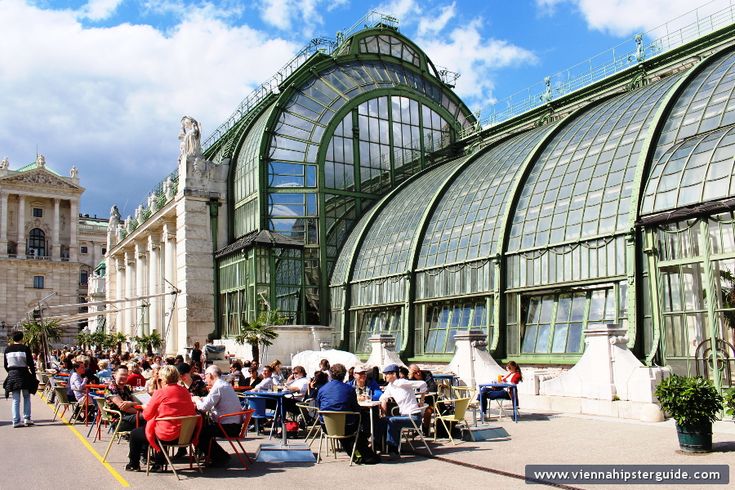
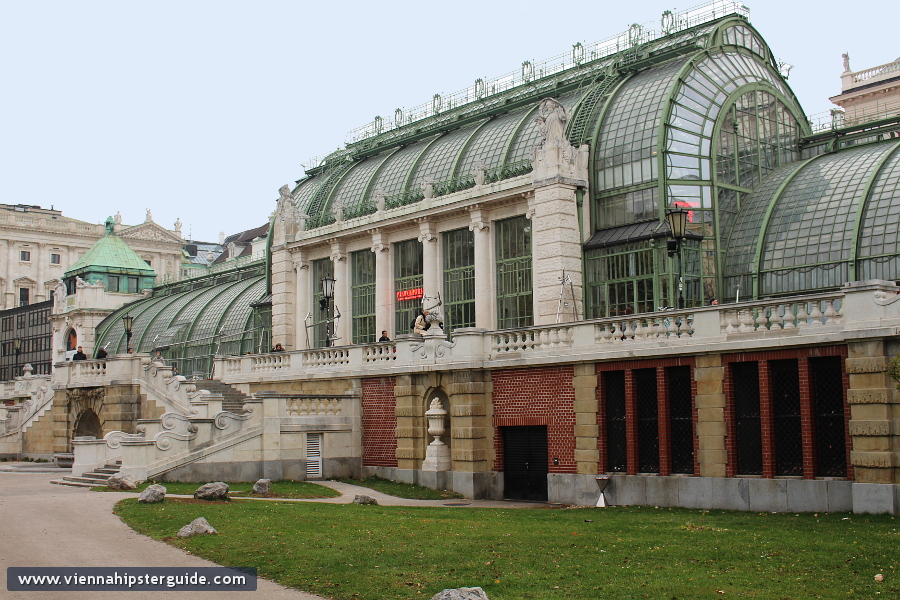
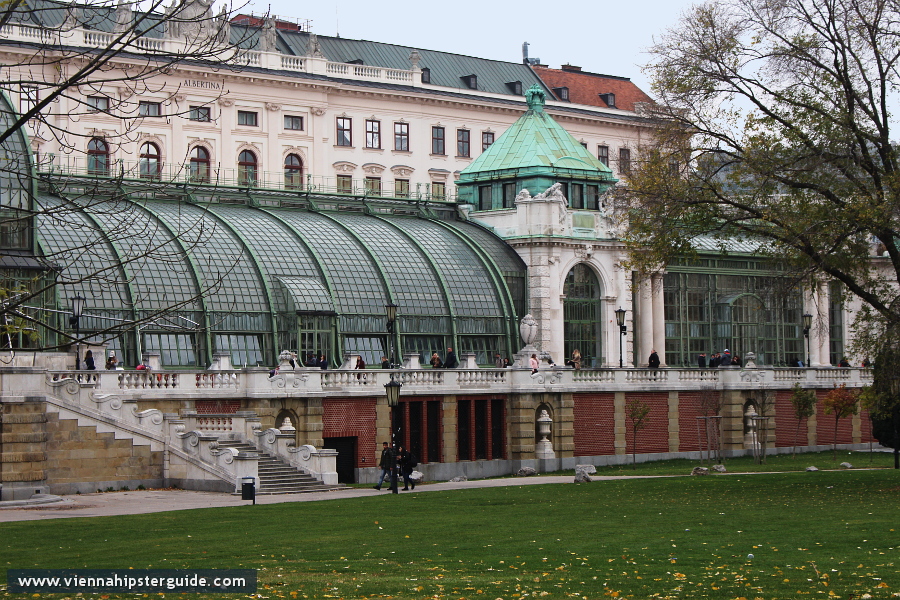
14.) Anker Clock / Ankeruhr - by Franz von Matsch
Address: Hoher Markt 10-11, 1010 Wien
The Anker Clock, located in the heart of Vienna’s Hoher Markt, is a striking example of Art Nouveau public art and design. Created by Franz von Matsch, the clock is not just a timepiece but a beautiful fusion of functional art and storytelling. The clock's facade, adorned with ornate metalwork and colorful mosaics, tells the history of Vienna through 12 historical scenes. Tourists can watch the clock’s hourly show, where mechanical figures come to life, and explore how Art Nouveau transformed everyday objects into mesmerizing, visually stimulating works of art. A visit here is a must for those interested in Vienna’s architectural evolution.
15. Loos Haus, now Raiffeisen Bank - by Adolf Loos
Address: Michaelerplatz 3, 1010 Wien
Loos Haus, designed by Adolf Loos, is one of Vienna's most controversial and influential buildings. Located at Michaelerplatz, its minimalist design stands in stark contrast to the elaborate ornamentation of other contemporary buildings. Loos rejected excessive decoration, advocating for functionalism and simplicity. The building’s clean lines and lack of decoration sparked debate, but it ultimately marked a major shift toward modernist architecture. Today, visitors can explore the building's timeless appeal and its legacy in shaping the future of architecture, making it an essential stop for those interested in the evolution of design philosophy.
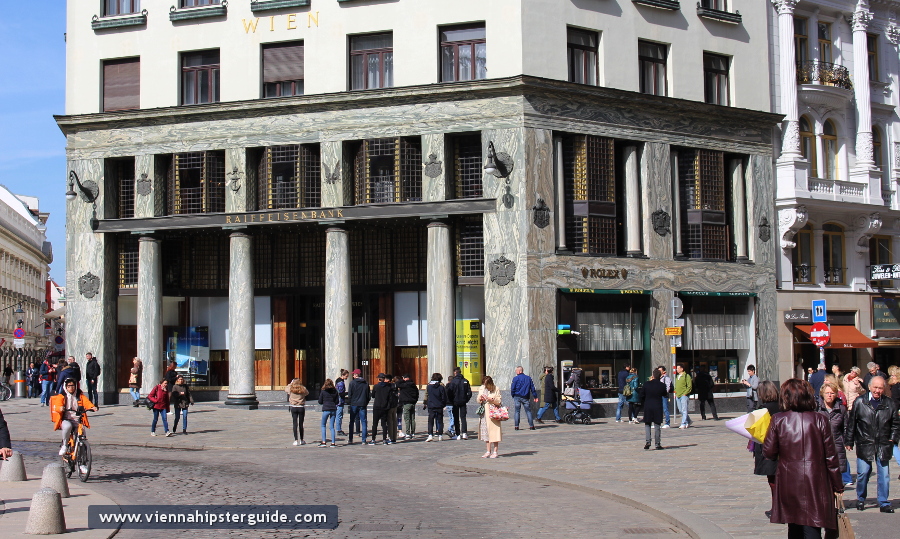
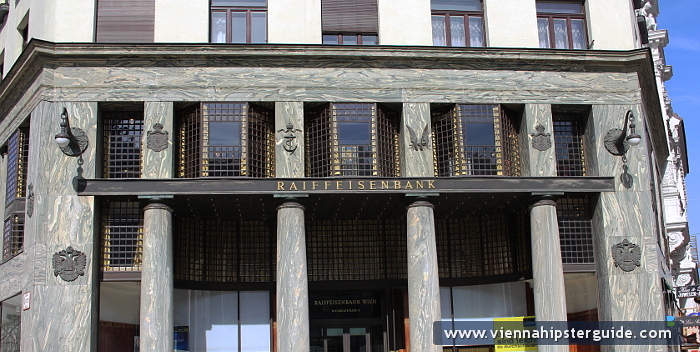
16.) Loosbar - by Adolf Loos
Address: Kärntner Durchgang 10, 1010 Wien
Web: American bar
Loosbar, also designed by Adolf Loos, is a small but significant part of Vienna’s architectural history. Located at Kärntner Durchgang, this intimate bar exemplifies Loos’ philosophy of minimalism, with its simple yet luxurious design. The dark wood paneling, brass accents, and low lighting create a cozy, understated elegance that makes it a perfect spot for visitors to experience Loos’ vision of modern interiors. The bar offers a unique opportunity to step into a space that reflects Loos’ groundbreaking approach to design, where every element is carefully considered and aesthetically pleasing in its simplicity.
17.) Knize & Comp, Store for men's fashion - by Adolf Loos
Address: Graben 13, 1010 Wien
Knize & Comp, designed by Adolf Loos, is a remarkable example of his architectural approach applied to a retail space. Located at Graben 13, this store for men’s fashion blends luxurious materials with Loos’ minimalist style. The interior design is characterized by its clean lines, rich woods, and a sense of understated elegance. Visitors will appreciate the harmonious balance between the building’s utilitarian function and its sophisticated aesthetic. As a testament to Loos’ design principles, this store provides a fascinating glimpse into early 20th-century retail architecture and the evolution of interior design.
18.) MANZ bookshop store front - by Adolf Loos
Address: Kohlmarkt 16, 1010 Wien
The MANZ Bookshop, located at Kohlmarkt, is another example of Adolf Loos’ refined architectural vision. The bookshop's facade showcases Loos' minimalist style, with a carefully composed design that focuses on simple, clean lines and high-quality materials. The building’s discreet elegance contrasts with the ornate facades typical of Vienna’s historic buildings. Visitors to MANZ can not only explore the wide selection of books but also appreciate how Loos transformed everyday commercial spaces with his innovative design philosophy. It’s an excellent example of how functionality and aesthetic beauty can seamlessly coexist in modern architecture.

2. Bauhaus, Art Deco:
Here are couple of prime examples of the Bauhaus architecture movement, located in Vienna.
1. Wittgenstein House - by Ludwig Wittgenstein and Paul Engelmann
Address: Parkgasse 18, 1030 Wien
Designed by philosopher Ludwig Wittgenstein and architect Paul Engelmann, the Wittgenstein House is a key example of modernist architecture in Vienna. Built in 1928, this Bauhaus-inspired building features clean lines, functional design, and a stark contrast to the ornate historical styles of the time. Visitors can marvel at the minimalist facade and the interior’s innovative approach to space and light. A visit here offers an insight into the intersection of philosophy and architecture, showcasing Wittgenstein’s belief in simplicity and clarity. Tourists interested in early 20th-century modernism will appreciate the house’s role in shaping architectural history.
2. Karl-Marx-Hof - by Karl Ehn
Address: near Boschstraße, 1190 Wien
Karl-Marx-Hof, completed in 1930 by architect Karl Ehn, is one of the largest and most impressive social housing projects in Europe. This monumental building complex is a prime example of the "Red Vienna" movement, which aimed to provide affordable housing with a focus on social welfare. Its Bauhaus-inspired design features geometric forms, functional spaces, and an emphasis on light and air. Tourists visiting Karl-Marx-Hof will be struck by its imposing yet welcoming structure, as well as its historical significance in shaping urban living during the interwar period. It’s a must-see for those interested in architecture’s role in social change.
3. Werkbundsiedlung / Council Estate - by Josef Frank, Adolf Loos, Josef Hoffmann, Margarete Schütte-Lihotzky
Address: Woinovichgasse, Weitingergasse, Jagdschloßgasse, Jagicgasse, 1130 Wien
Web: Council Estate
The Werkbundsiedlung, built in 1932, is a pioneering housing complex designed by prominent architects like Josef Frank, Adolf Loos, Josef Hoffmann, and Margarete Schütte-Lihotzky. This collaborative project embodies the principles of the Bauhaus movement and modernist design, offering a vision of functional, stylish, and efficient urban living. Visitors can explore the diverse architectural styles within the estate, which features flat roofs, open layouts, and a blend of traditional and modern materials. A tour of the Werkbundsiedlung provides valuable insights into the development of modern urban living and is an essential stop for architecture enthusiasts.
3. Eco architecture:
Here are 2 examples of eco architecture in Vienna, pioneered by Friedensreich Hundertwasser.
1. Hundertwasser Village
Address: Kegelgasse 37-39, 1030 Wien
Web: www.hundertwasser-village.com
Hundertwasser Village, completed in 1990, is a unique creation by the Austrian artist and architect Friedensreich Hundertwasser. This vibrant complex features whimsical, irregular shapes, undulating floors, and colorful facades, with a focus on integrating nature into urban life. Visitors will be fascinated by the organic, tree-lined design, as well as the unconventional use of tiles, mosaics, and golden domes. Hundertwasser’s signature style is an expression of eco-consciousness and individualism, making this village a perfect spot for tourists seeking a distinctive architectural experience. It’s a must-see for those interested in sustainable and artistic architecture.


2. Kunst Haus Wien, Museum Hundertwasser
Address: Untere Weißgerberstraße 13, 1030 Wien
Web: www.kunsthauswien.com
Kunst Haus Wien, designed by Friedensreich Hundertwasser and opened in 1991, is a museum dedicated to his work and philosophy. The building itself is a testament to his architectural style, with its colorful, irregular shapes, organic forms, and integration of nature. Tourists can explore Hundertwasser’s vision of eco-architecture while admiring his art, which focuses on vibrant, natural motifs. The museum also highlights his commitment to environmental sustainability and human well-being. Visiting Kunst Haus Wien offers a unique chance to experience Hundertwasser’s world, where art and architecture come together in a harmonious and thought-provoking way.



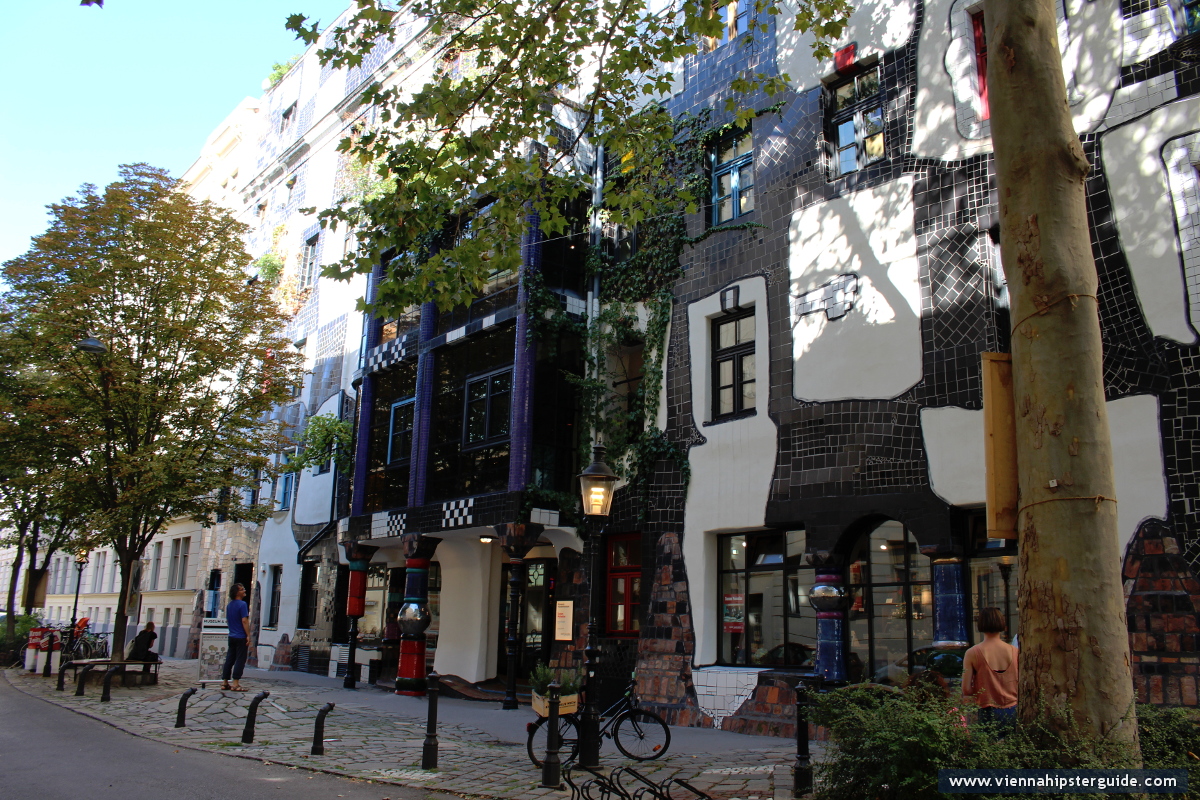


4. Modern (post-1960s):
1.) Campus of the Vienna University of Economics and Business
Address: Welthandelsplatz 1, 1020 Wien
Web: WU campus
Architect: Zaha Hadid
The Vienna University of Economics and Business (WU) campus, designed by renowned architect Zaha Hadid, is a striking example of contemporary architecture. Completed in 2013, the campus features Hadid’s signature fluid and dynamic design, with curving lines and interconnected, futuristic structures. The campus integrates seamlessly with the city, combining innovative aesthetics with functional spaces. Tourists will be captivated by the bold forms and cutting-edge materials that characterize the campus, making it a must-see for architecture enthusiasts. It’s also a hub for students, so visitors can experience the vibrant energy of one of Europe’s leading business universities.
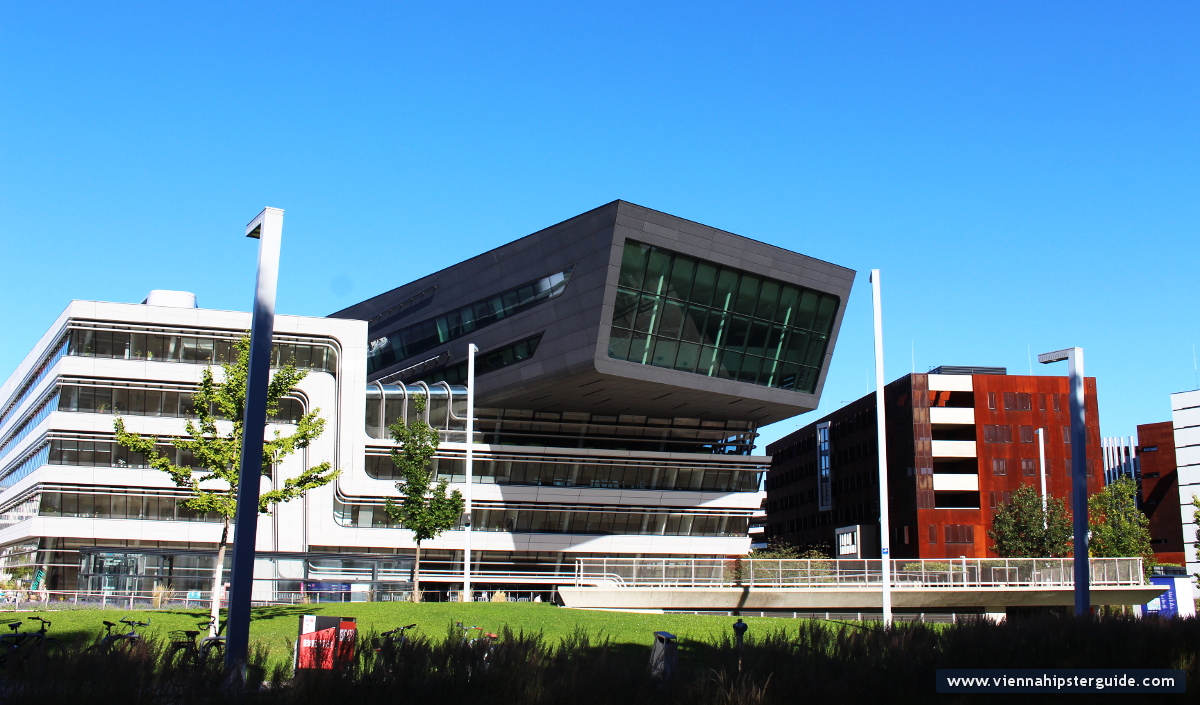








2.) Gasometer
Address: Guglgasse 6, 1110 Wien
Web: Gasometer shopping and cultural center
Architects: Jean Nouvel (Gasometer A), Coop Himmelblau (Gasometer B), Manfred Wehdorn (Gasometer C) and Wilhelm Holzbauer (Gasometer D)
The Gasometer, a group of four large gas storage tanks built in the late 19th century, is now a landmark of industrial architecture in Vienna. In the early 2000s, these historic structures were transformed into a mixed-use development, blending the old with the new. The renovation, which involved contributions from architects like Jean Nouvel and Coop Himmelb(l)au, retained the iconic facades while introducing modern housing, commercial spaces, and cultural facilities. Visitors can explore the combination of historic industrial design with contemporary architecture, making the Gasometer a fascinating destination for those interested in adaptive reuse and urban regeneration.

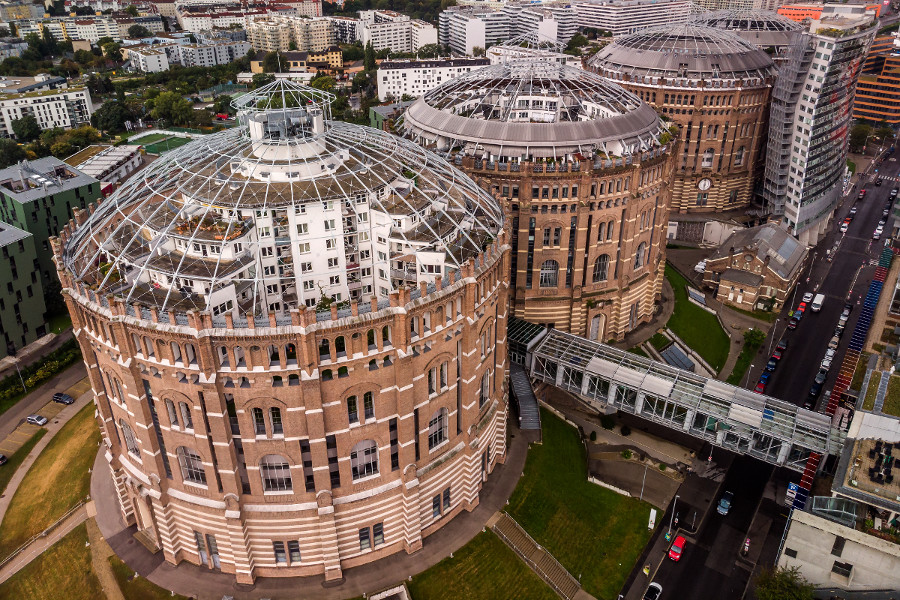
3.) Vienna Main Railway Station / Wien Hauptbahnhof
Address: Alfred-Adler-Straße 107, 1100 Wien
Web: BahnhofCity Wien Hauptbahnhof
Architect: Theo Hotz

4.) DC Tower 1
Address: Donau-City-Straße 7, 1220 Wien
Web: Vienna DC Towers
Architect: Dominique Perrault
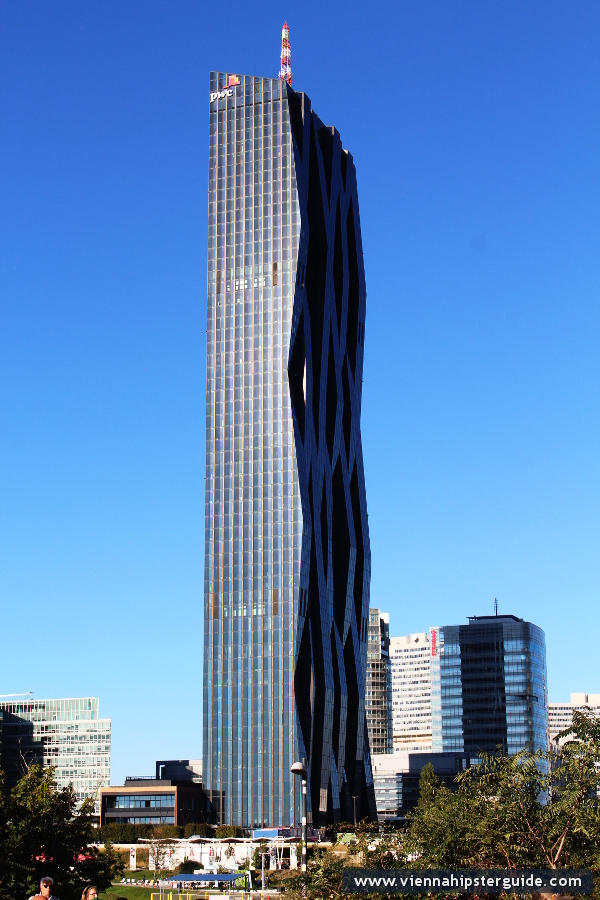
5.) Tech Gate Vienna
Address: Donau-City-Straße 9, 1220 Wien
Web: Tech Gate Vienna
Architect: Wilhelm Holzbauer and Sepp Frank

6.) Hochhaus Neue Donau / Seidler-Turm
Address: Wagramer Straße 4, 1220 Wien
Web: Harry Seidler & Associates
Architect: Harry Seidler

7.) Vienna International Centre (VIC)
Address: Wagramer Str. 5, 1400 Wien, Austria
Web: United Nations Office, Vienna
Architect: Johann Staber


8.) MQ / MuseumsQuartier: several buildings within the MQ
Address: Museumsplatz 1, 1070 Wien
Web: MuseumsQuartier Wien, Vienna
Architects: Laurids and Manfred Ortner, and others


9.) Haas House near Stephansplatz
Address: Goldschmiedgasse 3, 1010 Wien
Web: Hans Hollein website
Architect: Hans Hollein
10.) Vienna Twin Tower (Wienerberg City)
Address: Wienerbergstraße 11, 1100 Wien
Web: Vienna Twin Tower
and Wienerberg City
Architect: Massimiliano Fuksas
5. Where to learn more about Vienna's architecture?
Find out more stories and in-depth information about the city's architectural heritage and planned future by taking a trip to the local architecture museum.
Az W - Architekturzentrum Wien / The Austrian Architecture Museum
Address: MuseumsQuartier, Museumsplatz 1, 1070 Wien
Web: www.azw.at
The Az W - Architekturzentrum Wien, located in the vibrant MuseumsQuartier, is Austria’s premier institution dedicated to architecture. Housed in a stunning contemporary building designed by the architects Laurids and Manfred Ortner, the museum offers an immersive exploration of architectural history, theory, and innovation. Visitors can enjoy a wide range of exhibits that cover both Austrian and international architectural achievements, with a focus on sustainable design, urban planning, and architectural culture. The museum hosts temporary exhibitions, lectures, and events that provide valuable insights into the evolving world of architecture. For tourists, Az W is a must-visit for those looking to deepen their understanding of the built environment and to explore the intersection of design, technology, and society. With its dynamic exhibits and interactive presentations, Az W offers a thought-provoking experience for anyone with an interest in architecture and urban design.





